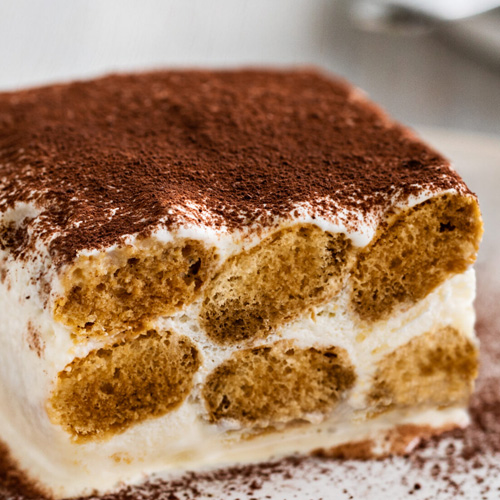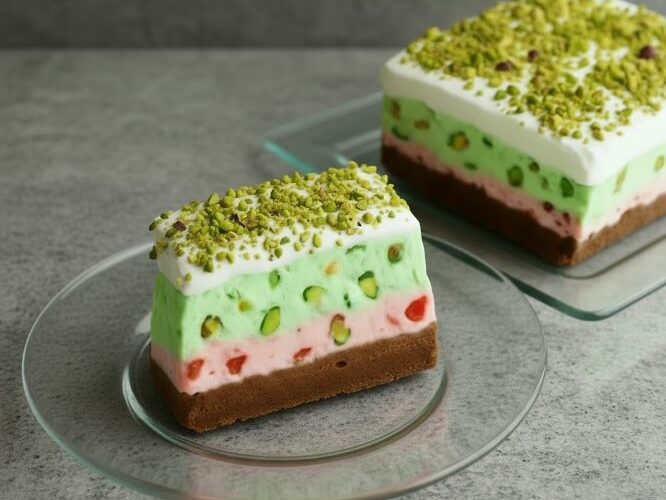Tiramisu: Italy’s Modern Dessert Legend
Tiramisu may feel timeless, but it’s actually a modern dessert. Compared to Sicily’s cassata or Naples’ sfogliatella, it’s quite new. Most historians agree it appeared in the Veneto region in the 1960s or 1970s, likely in Treviso. Unlike many Italian sweets born in convents or noble kitchens, tiramisu rose to fame in restaurants. It reflects a more contemporary dining culture.
The name says it all. Tirami sù in Italian means “pick me up” or “cheer me up.” The dessert delivers exactly that. Espresso-soaked ladyfingers combine with mascarpone cream, sugar, eggs, and a dusting of cocoa powder. Each spoonful offers comfort and energy in perfect balance.
Some claim tiramisu evolved from older northern Italian layered desserts. However, most credit Treviso’s restaurant Le Beccherie. There, chefs layered simple ingredients to create something indulgent yet approachable. Word spread quickly, and tiramisu soon became popular far beyond Veneto.
Global Fame
By the 1980s and 1990s, tiramisu appeared on menus from Paris to New York. It earned a reputation as both luxurious and comforting. Its appeal lies in contrasts: bold coffee meets creamy mascarpone, airy ladyfingers meet rich layers, and cocoa adds just the right touch of bitterness.
Tiramisu is highly versatile. Some recipes replace espresso with liqueurs like Marsala or amaretto. Others experiment with fruit, pistachios, or matcha for a modern twist. Yet the classic version remains the benchmark: elegant, satisfying, and unmistakably Italian.
From a small Venetian restaurant to a worldwide symbol of dolce vita, tiramisu proves that even a modern dessert can become an icon. Its creamy layers, rich coffee flavor, and simple elegance continue to delight people everywhere.
Making mascarpone cream at home is easier than you think and way more satisfying than buying a tub from the store. With just a few simple ingredients and a little whisking (or elbow grease), you can whip up a luxuriously creamy, dreamy filling that will have everyone wondering if you secretly hired an Italian pastry chef. Bonus: no fancy equipment required, just patience… and maybe a coffee break while it thickens.
Mascarpone Cream Recipe
Serving
What makes tiramisu truly special is its versatility. It can be dressed up as an elegant finale for a fine dinner party or enjoyed casually as a comforting slice on a quiet afternoon. Its charm lies in the way it feels both luxurious and approachable at the same time.
Over the years, tiramisu has inspired endless variations from versions infused with liqueurs like Marsala or amaretto to modern twists featuring fruit, pistachio, or even green tea. Still, the classic remains unmatched, a timeless reminder of how a few humble ingredients can be transformed into something extraordinary.
Serve tiramisu chilled straight from the fridge for the creamiest, most luscious experience. Cut into generous squares or scoops, dust each portion with a fresh sprinkle of cocoa powder, and optionally top with chocolate shavings or a few coffee beans for flair. Pair it with a hot espresso, a glass of sweet dessert wine, or simply enjoy it on its own.
Variations
Liqueur Twist: Swap or add Marsala with amaretto, Kahlúa, or rum for an extra boozy kick.
Fruit & Nut: Layer in fresh berries, chopped pistachios, or even figs for a modern, colorful spin.
Chocolate Lover’s: Mix in melted dark or white chocolate into the mascarpone cream, or sprinkle chocolate chips between layers.
Mini Servings: Make individual tiramisu cups in small glasses — perfect for parties or elegant plating.
Storage
Keep tiramisu covered in the fridge for up to 3 days to maintain its creamy texture and rich flavor. Avoid freezing, if possible, as the delicate layers of mascarpone cream and soaked ladyfingers can become watery or grainy when thawed. For best results, slice just before serving and always dust with cocoa powder right before plating.
Avoid Freezing
For the best flavor and texture, it’s better not to freeze tiramisu. The delicate mascarpone cream and coffee-soaked ladyfingers can become watery or grainy when thawed, losing that signature velvety smoothness. Instead, store it in the fridge.
Tiramisu can be frozen, but it requires careful handling to keep its texture intact. Wrap the dish tightly in plastic wrap and then in aluminum foil to prevent freezer burn. Freeze for up to 2 months. When ready to serve, thaw overnight in the refrigerator. Keep in mind that freezing may change the texture of the mascarpone cream and ladyfingers, so the dessert may be a bit softer than fresh. Dust with cocoa powder just before serving for the best presentation.













